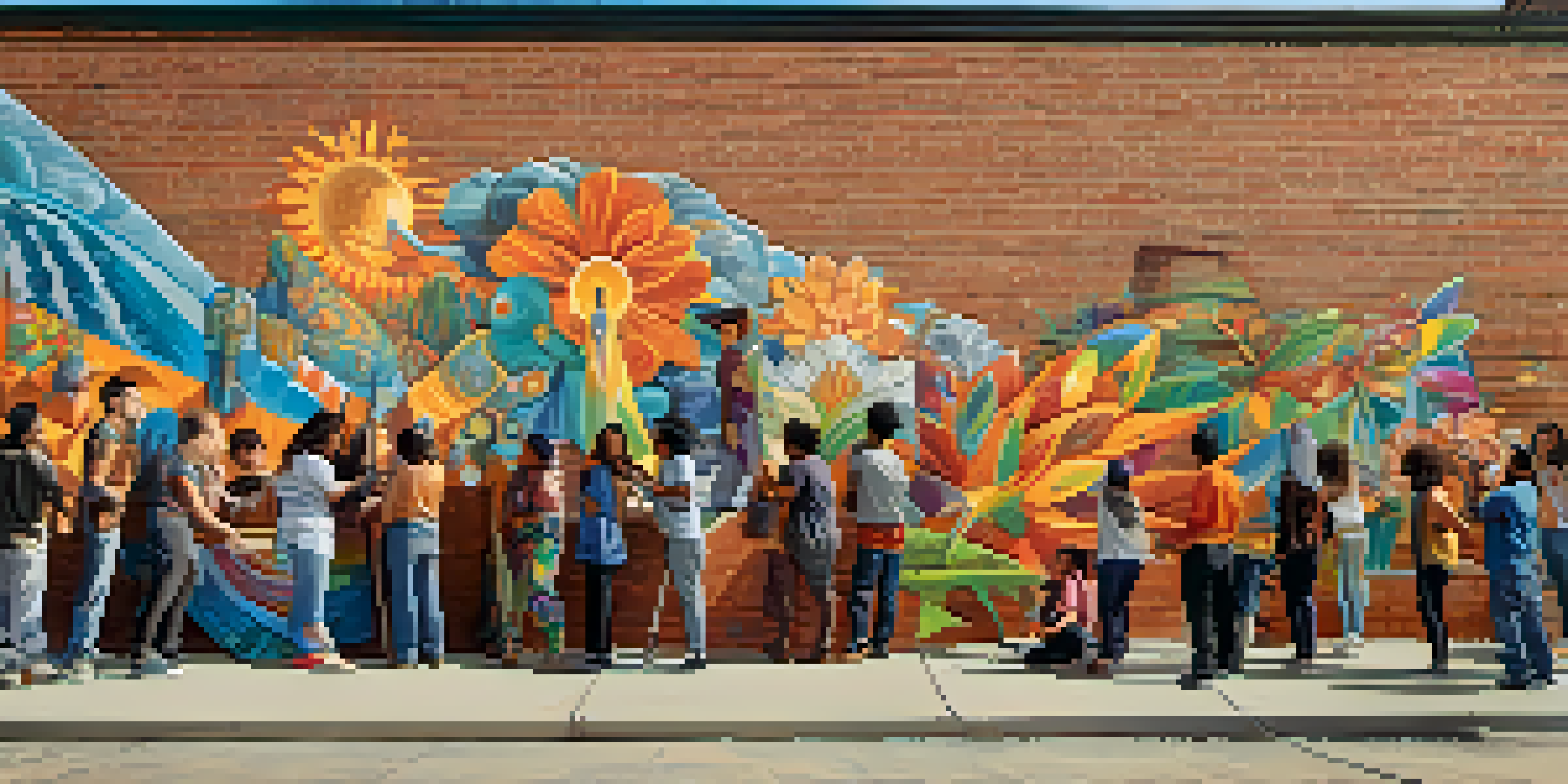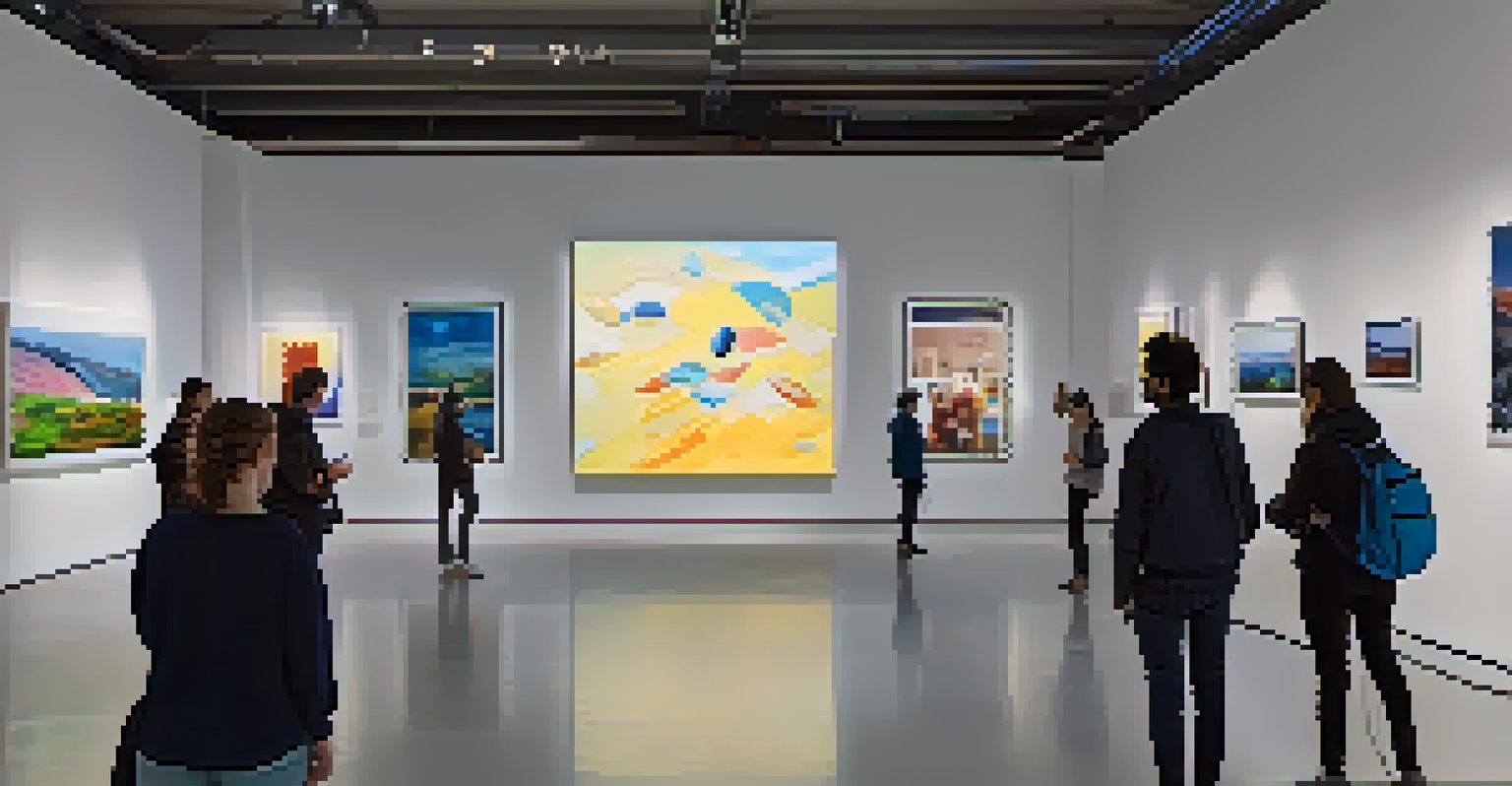The Power of Art: Collective Projects in Diverse Communities

Art as a Catalyst for Community Engagement
Art has a unique ability to bring people together, fostering a sense of belonging. Collective art projects invite individuals from various backgrounds to collaborate, creating shared experiences that strengthen community ties. For instance, a mural project can transform a neighborhood by allowing locals to express their stories visually, enhancing pride and connection.
Art is not freedom from discipline, but disciplined freedom.
These projects often serve as platforms for dialogue, where participants can share their perspectives and cultural narratives. By engaging in the creative process, community members not only learn about each other but also develop mutual respect and understanding. This dialogue is crucial in today’s world, where divisions often overshadow connections.
Moreover, art can highlight local issues, drawing attention to challenges that communities face. When artists and residents collaborate, they can address these issues creatively, inspiring action and change. This collective effort not only beautifies the area but also empowers participants to advocate for their community.
Fostering Inclusivity Through Collaborative Art
Inclusive art projects ensure that everyone, regardless of age, background, or ability, has a voice. These initiatives often involve workshops where participants learn new skills while contributing to a collective piece. This hands-on experience helps break down barriers and encourages participation from community members who might otherwise feel marginalized.

For example, intergenerational art projects can bridge gaps between the young and old, allowing them to learn from each other. A shared creative endeavor fosters understanding and appreciation across generations, enriching the community’s cultural tapestry. Inclusivity in art not only celebrates diversity but also cultivates a spirit of unity.
Art Fosters Community Ties
Collective art projects create shared experiences that strengthen connections among community members.
Additionally, these projects can reflect the unique identity of the community. By incorporating various cultural influences and artistic styles, the final work resonates with a broader audience. Celebrating this diversity in collaboration can lead to a richer, more vibrant artistic expression that truly represents the community.
Healing Through Art in Diverse Communities
Art has therapeutic qualities that can aid healing, especially in diverse communities facing trauma. Collective art projects provide a safe space for individuals to express their emotions and experiences creatively. This process can be particularly beneficial for those dealing with grief, displacement, or social injustice, as it allows them to channel their feelings into a tangible form.
Creativity takes courage.
For instance, community art therapy sessions often involve creating murals or installations that reflect shared struggles. Participants may find solace in knowing they are not alone in their experiences, fostering a sense of solidarity and healing. This collaborative approach helps individuals reclaim their narratives and find empowerment through creativity.
Furthermore, the act of creating together can build resilience within communities. As individuals overcome personal challenges through art, they also strengthen their bonds with one another. This collective resilience is essential in navigating future difficulties, making art a powerful tool for community healing.
Celebrating Cultural Heritage Through Art Projects
Art serves as a powerful medium for celebrating and preserving cultural heritage. Collective art projects often highlight the unique traditions and histories of diverse communities, allowing participants to share their stories with others. For example, festivals that incorporate traditional arts and crafts can educate the broader community about different cultures, fostering appreciation and respect.
Engaging in these projects not only honors the past but also inspires future generations. Young participants learn about their cultural roots while contributing to a living legacy that they can carry forward. This connection to heritage can instill pride and a sense of belonging, essential elements for community cohesion.
Inclusivity in Artistic Expression
Collaborative art initiatives ensure everyone has a voice, promoting understanding and appreciation across diverse backgrounds.
Moreover, showcasing these cultural expressions can attract attention and resources to underrepresented communities. By elevating their voices through art, these communities can advocate for their needs and rights. It’s a way to not only celebrate diversity but also to empower marginalized groups within the larger society.
The Role of Technology in Collaborative Art Projects
In today’s digital age, technology plays a significant role in enhancing collective art projects. Social media platforms and online collaboration tools enable artists and community members to connect and share ideas beyond geographical boundaries. This virtual space can amplify voices and foster cross-cultural collaborations, enriching the creative process.
For instance, digital murals and virtual art exhibitions allow communities to showcase their work to a global audience. These platforms provide opportunities for feedback and engagement, creating a dialogue that transcends local connections. This expanded reach can also inspire others to initiate similar projects in their own communities.
Additionally, technology can facilitate the documentation and preservation of collective art initiatives. Video recordings, blogs, and social media posts can capture the journey of creation, allowing future generations to learn from and appreciate these efforts. By blending traditional art forms with modern technology, communities can create a dynamic narrative of their artistic evolution.
Challenges and Solutions in Community Art Projects
While collective art projects can be incredibly rewarding, they also come with their own set of challenges. Issues such as funding, varying levels of artistic skill, and differing community priorities can complicate the process. However, these obstacles can often be overcome through effective communication and collaboration among all stakeholders.
One solution is to involve community members in the planning stages, ensuring that the project aligns with their interests and needs. By prioritizing their input, organizers can create a sense of ownership and commitment to the project. Additionally, seeking partnerships with local businesses or organizations can provide essential resources and support.
Art as a Healing Tool
Art provides a therapeutic outlet for individuals in diverse communities, fostering resilience and solidarity through shared creative expression.
Ultimately, flexibility is key to navigating these challenges. As projects evolve, being open to adapting ideas and approaches can lead to innovative solutions. This adaptability not only enhances the artistic process but also fosters a resilient community spirit.
The Lasting Impact of Collective Art on Communities
The effects of collective art projects extend far beyond their completion. They often leave a lasting imprint on the community, inspiring ongoing creativity and collaboration. Many projects become catalysts for further artistic endeavors, encouraging residents to continue exploring their creativity together.
Moreover, the relationships forged during these projects can lead to a stronger, more interconnected community. As individuals collaborate, they forge friendships and build networks that can support future initiatives. This sense of camaraderie can create a culture of collaboration that benefits the entire community.

In essence, collective art projects not only beautify spaces but also transform lives. By fostering connections, celebrating diversity, and promoting healing, these initiatives contribute to a more vibrant and resilient community. The power of art truly lies in its ability to unite, inspire, and empower diverse voices.